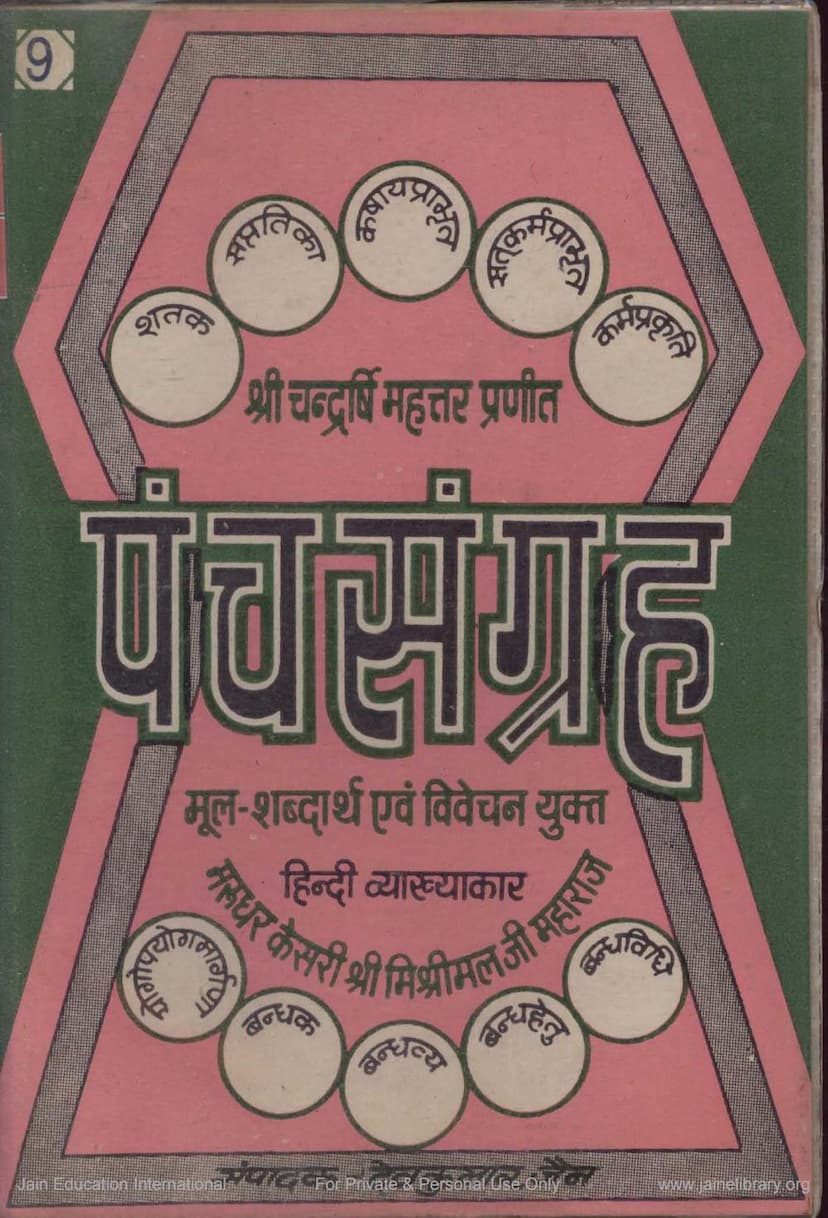Panchsangraha Part 09
Added to library: September 2, 2025

Summary
Here is a comprehensive summary of the Jain text "Panchsangraha Part 09," focusing on the content derived from the provided pages:
Book Title: Panchsangraha (पंचसंग्रह) Author: Acharya Chandrashi Mahattar (आचार्य चन्द्रर्षि महत्तर) Commentary/Explanation: Shri Mishrimalji Maharaj (श्री मिश्रीमलजी महाराज) Publisher: Acharya Shri Raghunath Jain Shodh Sansthan, Jodhpur (आचार्य श्री रघुनाथ जैन शोध संस्थान, जोधपुर)
Core Subject: This part of the Panchsangraha, specifically the "Upashamanaadi Karan Traya Praroopana Adhikara" (उपशमनादि करणत्रय-प्ररूपणा अधिकार), delves deeply into the three types of 'karanas' (actions or processes) related to the modification of karmas: Upashamana (उपशमना), Niddhatti (निद्धत्ति), and Nikachana (निकाचना). The central theme revolves around how living beings, through their spiritual practices and resultant soul-states (adhyavasaayas), modify the karmic particles (karmadalikas) that bind them to the cycle of birth and death.
Key Concepts Explained:
-
Karmas as the Root of Suffering: The text begins by emphasizing that karma is the fundamental reason for the soul's transmigration and suffering in the cycle of existence. It clarifies that karmas are not independent forces but rather physical substances (pudgala) that become potent and binding due to the soul's attachment and aversion (raag-dwesh).
-
The Three Karana-s:
- Upashamana (उपशमना): This is the primary focus. It refers to the pacification or suppression of karmic states.
- Sarvopashamana (सर्वोपशमना - Complete Pacification): This only applies to the Mohaniya Karma (delusion-inducing karma). It is achieved through three specific 'karanas': Yathapravritta, Apoorva, and Anivritta Karanas. Sarvopashamana leads to the attainment of "upshama samyakva" (temporary right-belief).
- Deshopashamana (देशोपशमना - Partial Pacification): This can apply to all eight types of karmas. It involves pacifying only a portion of the karmic particles. Deshopashamana can occur through or without the three special 'karanas'.
- Niddhatti (निद्धत्ति): This involves establishing karmic particles in a state where only 'udvartana' (increasing duration) and 'apvartana' (decreasing duration) can operate, but not 'sankrama' (transmutation).
- Nikachana (निकाचना): This is the final stage where karmic particles become incapable of undergoing any modification ('karana').
- Upashamana (उपशमना): This is the primary focus. It refers to the pacification or suppression of karmic states.
-
The Three Special Karana-s (Yathapravritta, Apoorva, Anivritta): These are crucial for achieving Sarvopashamana and are explained in detail. They represent progressive stages of spiritual purification and intensity of refined mental states (adhyavasaaya).
- Yathapravritta Karana (यथाप्रवृत्तकरण): The initial stage of spiritual effort. It involves increasing purity ('vishuddhi') from moment to moment, with variations in purity ('jaghanya' and 'utkrushta').
- Apoorva Karana (अपूर्वकरण): This stage involves new and unprecedented levels of spiritual effort and purity. It is characterized by 'sthiti-ghata' (reduction in karma duration), 'rasa-ghata' (reduction in karma intensity), 'guna-shreni' (formation of a ladder of increasing virtues), and 'bandhaka-addhaa' (new, shorter karma duration binding). These are 'apoorva' (unprecedented) because they haven't occurred before in this manner.
- Anivritta Karana (अनिवृत्तिकरण): The final stage of this process, where the purity of effort is absolute and unchanging for each moment. It involves further intensification of the processes initiated in Apoorva Karana and culminates in the modification of karma. The purity in this stage is described as 'shuddha' (pure) and 'muktaavali-sansthita' (arranged like a pearl necklace).
-
Stages of Samyakva (Right-Belief): The text explains how one attains 'upshama samyakva' (temporary right-belief) through these 'karanas'. It details the conditions and qualifications of the soul necessary for this attainment. It also discusses the subsequent states like 'saasadanbhava' (a state of falling from right-belief) and the progression through different soul-states (Gunasthana).
-
Modification of Mohaniya Karma: A significant portion of the text focuses on how Mohaniya Karma, particularly the delusion-inducing aspects (Mithyatva, Mishra, and Samyakva Mohaniya), are modified through 'upshama' and 'kshapana' (destruction). The text meticulously details the stages, the specific karmic changes, and the resulting spiritual progress.
-
Other Karmas: While Mohaniya Karma is central, the text also touches upon the modification of other karmas, including the lifespan-setting karmas (Ayush Karma) and the consequences of these modifications on the soul's journey.
-
The Role of Intent and Effort: The text consistently emphasizes that the intensity, purity, and nature of the soul's intentional efforts (adhyavasaaya) are directly responsible for the type and extent of karmic modification.
-
Biographical Tribute: The introductory pages include a significant tribute to Shri Mishrimalji Maharaj, highlighting his scholarship, dedication to propagating Jain knowledge, and his role in initiating this commentary. It also mentions the contributions of Shri Devkumar Jain (editor) and Shri Sukhnmundiji Maharaj (compiler/facilitator).
Overall Significance: "Panchsangraha Part 09" is a profound and detailed exploration of the intricate mechanisms by which karmas are transformed through spiritual practice in Jainism. It provides a systematic understanding of the 'karanas' that lead to the pacification and eventual elimination of karmic bondage, ultimately paving the path to liberation. The commentary by Shri Mishrimalji Maharaj makes this complex subject accessible, while the editorial work ensures its accurate presentation. The text is considered a vital resource for serious students of Jain philosophy and the science of karma.